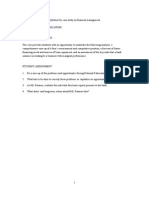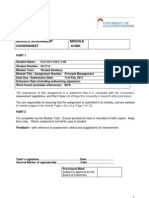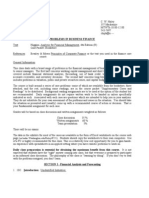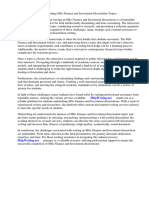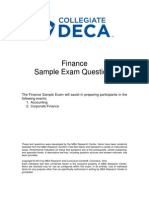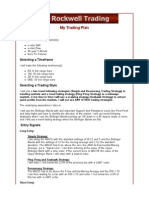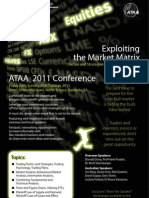Merton
Merton
Uploaded by
rajivagarwalCopyright:
Available Formats
Merton
Merton
Uploaded by
rajivagarwalCopyright
Available Formats
Share this document
Did you find this document useful?
Is this content inappropriate?
Copyright:
Available Formats
Merton
Merton
Uploaded by
rajivagarwalCopyright:
Available Formats
Case Map for Bodie & Merton: Financial Economics (Prentice Hall)
This map was prepared by an experienced editor at HBS Publishing, not by a teaching professor. Faculty at Harvard Business School were not involved in analyzing the textbook or selecting the cases and articles. Every case map provides only a partial list of relevant items from HBS Publishing. To explore alternatives, or for more information on the cases listed below, visit: hbsp.harvard.edu
I. FINANCE AND THE FINANCIAL SYSTEM Chapter 1: Financial Economics Nick Fiore: Healer or Hitman? (A) : Clayton M. Christensen, Tara Donovan Product #: 601062 Length: 17p Abstract Presents the predicament many general managers face at one time or another: if I don't deliver the numbers, senior management won't invest in our growth. But what it takes to deliver the desired numbers may include layoffs and other undesirable solutions. Is it better to back off the short-term solutions and weather the revenue losses, or will cutting back in the short term actually help to deliver the long-term results? Looks at one general manager's struggle with these issues. Learning Objective: Helps students confront the reality that amongst the intellectual appeal of strategic planning, high technology, financial engineering, and market segmentation lies the relentless reality that managers must deliver results and that the data they need, in order to take small corrective actions before larger disasters occur, resides in the divisions and in the functions. Explores the challenges facing Tim Williams, the new CFO of a publicly-traded enterprise software company, as he attempts to rebuild his company's reputation for reliable financial reporting following a highly visible financial reporting crisis. Armed with an understanding of the company business model, sales cycle, and revenue recognition policy, Williams must assess how various factors contributes to the company's crisis, and which policies and business practices can be changed to ensure against future financial reporting issues. Learning Objective: Useful early in a course on financial reporting to develop a basic framework for the role of financial reporting and disclosure in the capital markets. Provides opportunities for discussing key aspects of the financial reporting system, including accrual accounting, management's responsibility for financial reporting, and the set of generally accepted accounting principles and audit practices that impose restrictions on management. Additionally, highlights the roles of capital market regulators (the SEC) and information intermediaries. The owner of a rapidly growing retail lumber company is considering the financial implications of continued rapid growth. The magnitude of the company's future financing requirements must be assessed in the context of the company's access to bank finance and/or equity finance. Learning Objective: To develop skills in financial analysis,
Policy Management Systems Corp.: The Financial Reporting Crisis: Amy P. Hutton Product #: 102013 Length: 10p
Clarkson Lumber Co. : Thomas R. Piper Product #: 297028 Length: 6p Teaching Note: 297076
financial forecasting, and financial planning. Chapter 2: Financial Markets and Institutions The Harmonized Savings Plan at BP Amoco: Luis M. Viceira Product #: 201052 Length: 17p Teaching Note: 206121
American International Group, Inc.: Kenneth A. Froot, Heidi Suzanne Nelson Product #: 200026 Length: 31p Morningstar, Inc. : Andre F. Perold, Markus F. Mullarkey Product #: 298140 Length: 24p
U.S. Bank of Washington : Scott P. Mason, Elizabeth R. Lawrence Product #: 292057 Length: 23p Teaching Note: 298021
Abstract On August 11, 1998, United States' Amoco Corp. merged with the British Petroleum Co. (BP). This case focuses on the issues surrounding the integration of the employee-defined contribution plans at Amoco and the U.S. subsidiary of BP. One of them was that the pre-merger plans had very different investment structures. The new plan, which would have more than 40,000 participants and $7 billion in assets, would have to either choose one of these approaches, or try to integrate them into one single structure. Learning Objective: To provide students with ample opportunities to discuss issues such as market efficiency, active versus passive (indexed) asset management, mutual fund performance evaluation, the design of private pension plans, and the mutual fund industry. American International Group, Inc. (AIG), one of the world's largest and most innovative insurers and financial intermediaries, is thinking about strategy in an era of new competition and Internet distribution. Learning Objective: To demonstrate issues associated with a large financial intermediary. Morningstar, Inc., a publisher of information for mutual fund investors, is considering alternative strategies for broadening its subscriber base and increasing its revenues. Potential strategies include tailoring information for the defined contribution pension fund marketplace, and licensing Morningstar's performance ratings to fund complexes. This case provides a setting in which to discuss the U.S. mutual fund industry, with particular focus on mutual fund performance measurement, and the information needs of consumers of mutual funds. Subjects Covered: Investment management; Mutual funds; Performance measurement A vice president of the U.S. Bank of Washington, a subsidiary of U.S. Bancorp, is asked to review a $6.5 million loan request from the Redhook Ale Brewery, a Seattle-based microbrewery. The case provides an understanding of the U.S. commercial banking industry and the role of a loan officer, and asks the student to assess a proposed loan. Provides an opportunity for financial statement and cash flow analysis. Subjects Covered: Cash flow; Financing; Loan evaluation
Chapter 3: Managing Financial Health and Performance Sears, Roebuck and Co. vs. Wal-Mart Stores, Inc.: Gregory S. Miller, Christopher F. Noe Product #: 101011 Length: 18p Teaching Note: 102052
Abstract This case is designed to familiarize students with the use of financial ratios. Two retailers, Sears, Roebuck and Co. and Wal-Mart Stores, Inc., have a very similar value for return on equity (ROE) in the 1997 fiscal year. Students use the information in the case and the accompanying exhibits, which include financial statements as well as disclosures regarding corporate strategies and accounting policies for each company, to analyze the value creation process for each firm.
This case provides a good introduction regarding the combination of such information to create a powerful tool for financial statement analysis. Subjects Covered: Financial analysis; Financial ratios; Financial statements; Return on equity Advanced Technologies, Inc. : Thomas R. Piper Product #: 299042 Length: 8p The CEO of a semiconductor equipment manufacturer is assessing the financial forecasts and financing plan prepared by the chief financial officer. Continued rapid growth will create substantial financing pressures, especially if profitability fails to recover and/or if a major, unexpected economic downturn occurs. Subjects Covered: Debt management; Financial analysis; Financial management; Financial planning The owner of a rapidly growing retail lumber company is considering the financial implications of continued rapid growth. The magnitude of the company's future financing requirements must be assessed in the context of the company's access to bank finance and/or equity finance. Learning Objective: To develop skills in financial analysis, financial forecasting, and financial planning. An introductory case in cash flow analysis and the preparation of statements of cash flows. Based on the 1991 income statement and balance sheet at a ski resort company, the case provides additional information which allows a student to prepare both a direct and an indirect statement of cash flows. Subjects Covered: Accounting policies; Cash flow; Management accounting
Clarkson Lumber Co. : Thomas R. Piper Product #: 297028 Length: 6p Teaching Note: 297076
Crystal Meadows of Tahoe, Inc. : William J. Bruns Jr. Product #: 192150 Length: 6p Teaching Note: 193128
II: TIME AND RESOURCE ALLOCATION Chapter 4: Allocating Resources Over Time Health Development Corp. : Richard S. Ruback Product #: 200049 Length: 5p Teaching Note: 201030
Ginnys Restaurant : Mark Mitchell Product #: 201099 Length: 2p Teaching Note: 202013 Tree Values : Richard S. Ruback, Kathleen S. Luchs Product #: 201031
Abstract Health Development Corp. (HDC) owns and operates health clubs in the Greater Boston area. HDC engaged a local investment banker to explore a sale of the company. The most likely buyer views HDC's prior purchase of real estate as a negative. HDC's management is convinced the purchase enhanced value, and a discounted cash flow analysis confirms that it was a substantially positive net present value decision. Nevertheless, the real estate reduces the valuation according to the approach used by the potential buyer. The challenge is to structure a transaction that allows HDC to realize its full value. Learning Objective: To show the relation between discounted cash flow techniques and multiples. An individual is considering the development of a new restaurant. To make the decision, she uses NPV analysis to determine whether she should undertake the investment, and if so, the optimal size of the investment. Learning Objective: To introduce net present value analysis. Describes two alternative tree-cutting strategies. The case presents information for students to estimate the cash flows for each alternative. After estimating the corresponding cash flows, students have the
Length: 3p Teaching Note: 202018
opportunity to use discounted cash flow techniques to decide when to cut trees under each strategy and to select which strategy maximizes the value of the forest. Subjects Covered: Capital budgeting; Cash flow; Present value; Valuation
Chapter 5: Household Saving and Investment Decisions Martin Smith: January 2000 : Josh Lerner Product #: 298076 Length: 9p Teaching Note: 202035
Social Security Reform : Robert E. Kennedy, Brian P. Irwin Product #: 799011 Length: 22p Teaching Note: 799095
Abstract An MBA student must choose between offers from three private equity organizations. Each organization has distinct strengths and weaknesses, and different implications for the student's career development. The case presents compensation and employment data about the private equity industry. Introduces the private equity industry and the key offerings between groups. Subjects Covered: Career planning; Financial analysis; Leveraged buyouts; Venture capital Examines various approaches to pension reform. Explores the current Social Security system in the United States, pension reform in other countries, and the leading approaches to reform. Concludes with analysis of three questions: 1) would returns be higher in a private system? 2) how could the transition to a new system be financed?, and 3) would privatization increase national savings? Subjects Covered: Government policy; Pension plans; Privatization
Chapter 6: The Analysis of Investment Projects Airbus A3XX: Developing the Worlds Largest Commercial Jet (A) : Benjamin C. Esty, Michael Kane Product #: 201028 Length: 20p Teaching Note: 201040
Pioneer Petroleum Corp. : Richard S. Ruback Product #: 292011 Length: 5p Teaching Note: 292080
Abstract In July 2000, Airbus Industrie's supervisory board is on the verge of approving a $13 billion investment for the development of a new super jumbo jet known as the A3XX. Having secured approximately 20 orders for the new jet, the board must decide whether there is sufficient long-term demand for the A3XX to justify the investment. At the time, Airbus was predicting that the market for very large aircraft (VLA) would exceed 1,500 aircraft over the next 20 years and would generate sales in excess of $350 billion. According to Airbus, it needed to sell 250 aircraft to break even, and could sell as many as 750 aircraft over the next 20 years. This case explores the two sets of forecasts, and asks students whether they would proceed with the launch given the size of the investment and the uncertainty in longterm demand. Learning Objective: To illustrate the basic economics of large projects and the complexity in estimating even top-line demand for products with useful lives of up to 50 years. Also illustrates the role of governments in large projects, both as investors and as customers. Pioneer is an integrated oil company. Its operations include exploration and development, production, transportation, and marketing. The case focuses on Pioneer's cost of capital calculations and its choice between a single company-wide cost of capital or divisional costs of capital. Provides students the opportunity to learn how to calculate a company-wide weighted average cost of capital. An appropriate measure of the cost of equity capital is presented so that students are able to challenge their understanding of key concepts by
Friendly Cards, Inc. : William E. Fruhan Product #: 293135 Length: 10p Teaching Note: 294114 Harris Seafoods, Inc. : William E. Fruhan, William A. Sahlman Product #: 281054 Length: 13p Investment Analysis and Lockheed Tri Star : Michael E. Edleson Product #: 291031 Length: 6p Teaching Note: 291032
critiquing the company's measure and suggesting their own. Subjects Covered: Capital budgeting; Capital costs Involves analysis of a major capital investment proposal, an acquisition of another company, an estimate of the funds required for these two possible outlays, and a recommended course of management action. Subjects Covered: Acquisitions; Capital budgeting; Capital expenditures; Securities analysis Presents data relevant to a major capital expenditure the construction of a shrimp plant. Designed to test students ability to identify relevant cash flows, to estimate the cost of capital, and to decide whether or not to invest. Subjects Covered: Capital costs; Financing; Securities analysis A set of five exercises in capital budgeting. Students calculate and compare various decision criteria (including IRR and NPV) for capital investment projects. This is an introductory case, where relevant cash flows are provided, and the focus is on the discounting mechanics and the decision to invest. In addition, one exercise directly probes the link between positive NPV projects, and value added to the shareholders. The final "exercise" is a three page mini-case analyzing Lockheed's decision to invest in the TriStar L-1011 Airbus project. This drives home the importance of discounting and NPV, and shows the adverse effect of a negative NPV project on shareholder value. Subjects Covered: Capital budgeting; Capital investments; Present value; Project evaluation; Securities analysis
III. VALUATION MODELS Chapter 7: Principles of Market Valuation The Harmonized Savings Plan at BP Amoco : Luis M. Viceira Product #: 201052 Length: 17p Teaching Note: 206121
Long-Term Capital Management, L.P. (A) : Andre F. Perold Product #: 200007 Length: 23p
Abstract On August 11, 1998, United States' Amoco Corp. merged with the British Petroleum Co. (BP). This case focuses on the issues surrounding the integration of the employee-defined contribution plans at Amoco and the U.S. subsidiary of BP. One of them was that the pre-merger plans had very different investment structures. The new plan, which would have more than 40,000 participants and $7 billion in assets, would have to either choose one of these approaches, or try to integrate them into one single structure. Learning Objective: To provide students with ample opportunities to discuss issues such as market efficiency, active versus passive (indexed) asset management, mutual fund performance evaluation, the design of private pension plans, and the mutual fund industry. Long-Term Capital Management, L.P. (LTCM) was in the business of engaging in trading securities to exploit market pricing discrepancies. LTCM generally sought to hedge the risk-exposure components of its positions that were not expected to add incremental value to portfolio performance, and to increase the value-added component of its risk exposures by borrowing to increase the size of its positions. The fund's positions were diversified across many markets. This case is set in September 1997, when, after three and a half years of high investment returns, LTCM's fund capital had grown to $6.7 billion. Because of the limitations imposed by available market liquidity, LTCM was
Eskimo Pie Corp. : Richard S. Ruback, Dean Mihas Product #: 293084 Length: 13p Teaching Note: 297073
Arbitrage in the Government Bond Market? : Michael E. Edleson, Peter Tufano Product #: 293093 Length: 9p Teaching Note: 296059
considering whether it was a prudent and opportune moment to return capital to investors. Learning Objective: To discuss a broad range of issues relating to arbitrage, market efficiency, implementation of investment strategies, liquidity shocks, risk management, financial intermediation, investment management, hedge funds, incentives, systemic risk, and regulation. In early 1991, Reynolds Metals, the makers of aluminum products, decided to sell its holding of Eskimo Pie, a marketer of branded frozen novelties. Reynolds had an offer from Nestle to acquire Eskimo Pie. However, Reynolds decided instead to make an initial public offering of Eskimo Pie shares. Learning Objective: To examine methods of selling a division of a large corporation and provides information about Initial Public Offerings. Documents a pricing anomaly in the large and liquid treasury bond market. The prices of callable treasury bonds seem to be inconsistent with the prices of noncallable treasuries and an arbitrage opportunity appears to exist. Permits instructors to introduce the treasury market, the concept of creating synthetic instruments, principles of arbitrage, and institutional frictions in the bond markets. Subjects Covered: Bonds; Capital markets; Securities analysis; Valuation
Chapter 8: Valuation of Known Cash Flows: Bonds Cougars : Scott P. Mason, Mihir A. Desai Product #: 295006 Length: 6p Teaching Note: 295098 Jupiter Management Co. : Ronald W. Moore Product #: 292107 Length: 24p Teaching Note: 298023 Arbitrage in the Government Bond Market? : Michael E. Edleson, Peter Tufano Product #: 293093 Length: 9p Teaching Note: 296059
Abstract Provides an introduction to zero coupon bonds and stripping coupon bonds. Concerns the relationship between the spot curve, the strip curve, and the coupon curve. Subjects Covered: Bonds; Innovation; Interest rates; Pricing The manager of a small company growth fund considers relative merits of investing in a company's convertible debt versus its common. Subjects Covered: Investment management; Mutual funds; Portfolio management Documents a pricing anomaly in the large and liquid treasury bond market. The prices of callable treasury bonds seem to be inconsistent with the prices of noncallable treasuries and an arbitrage opportunity appears to exist. Permits instructors to introduce the treasury market, the concept of creating synthetic instruments, principles of arbitrage, and institutional frictions in the bond markets. Subjects Covered: Bonds; Capital markets; Securities analysis; Valuation
Chapter 9: Valuation of Common Stocks Ford Motor Co.s Value Enhancement Plan : Andre F. Perold Product #: 201079 Length: 17p
Abstract In April 2000, Ford Motor Co. announced a shareholder Value Enhancement Plan (VEP) to significantly recapitalize the firm's ownership structure. Ford had accumulated $23 billion in cash reserves and under the VEP would return as much as $10 billion of this cash to shareholders. Students must wrestle with the following
Teaching Note: 204116
Global Equity Markets: The Case of Royal Dutch and Shell : Kenneth A. Froot, Andre F. Perold Product #: 296077 Length: 19p Teaching Note: 201093
Dividend Policy at FPL Group, Inc. (A) : Benjamin C. Esty, Craig F. Schreiber Product #: 295059 Length: 17p Teaching Note: 296072
questions: Why was Ford proposing this transaction instead of a traditional share repurchase or a cash dividend? How did the interests of the Ford family factor into this decision, and what did the transaction imply about the future involvement of the family in the company? Why was Ford distributing such a significant amount of cash at this particular point in time? Did the distribution signal a change in the company's appetite for making acquisitions or future capital expenditures? If shareholders collectively elected to receive less than $10 billion in cash, how would Ford distribute the remaining cash? Learning Objective: To provides a rich setting in which to discuss one of the most basic decisions corporations face: how to return cash to shareholders. It is a vehicle for discussing corporate financial policies and capital structure decisions, particularly as they relate to cash dividends and share repurchases. Royal Dutch and Shell common stocks are securities with linked cash flow, so that the ratio of their stock prices should be fixed. In fact, the ratio is highly variable, moving with the markets where the securities are intensively traded. Royal Dutch trades more actively in the Netherlands and U.S. markets, whereas Shell trades more actively in the United States. The result is that the Royal Dutch/Shell relative price moves positively with the Netherlands and U.S. markets and negatively with the U.K. market. The ability to arbitrage these disparities and their causes are major case focal points. Learning Objective: To demonstrate how valuation is affected by the location of trade/ownership, and why arbitrage doesn't lead to integration of international financial markets. A Wall Street analyst has just learned that FPL (the holding company for Florida's largest electric utility) may cut its dividend in several days despite a 47-year streak of consecutive dividend increases. In response to the deregulation of the electric utility industry, FPL has substantially revised its competitive strategy over the past several years. The analyst must decide whether a change in dividend policy will be a part of FPL's financial strategy. Learning Objective: To examine how firms set and change dividend policy. Also provides background for examining why firms pay dividends and whether dividend policy matters.
IV. RISK MANAGEMENT AND PORTFOLIO THEORY Chapter 10: Principles of Risk Management Harvard Management Co. 2001 : Jay O. Light Product #: 201129 Length: 23p The State of South Carolina: Randolph B. Cohen, Mark Mitchell Product #: 201061 Length: 31p Teaching Note: 201127
Abstract Harvard Management Co. uses portfolio theory to help consider the asset allocation issues for its endowment. Subjects Covered: Asset allocation; Financial management; Investment management; Portfolio management Considers the managerial decision faced by the state's treasurer in 1998. Until recently, the South Carolina state pension fund (with over $17 billion in assets) was barred by the state constitution from investing in equities. After the constitution was amended, the state government had to decide how much to invest in equities, and what assets to choose. Using domestic and international data, the concepts of standard deviation, correlation, covariance, diversification, and risk
Tiffany & Co. 1993 : W. Carl Kester, Kendall Backstrand Product #: 295047 Length: 12p Teaching Note: 298014
Jaguar plc 1984 : Timothy A. Luehrman, William T. Schiano Product #: 290005 Length: 13p Teaching Note: 290034
are introduced. The case also looks at the equity premium from a global setting. Learning Objective: To introduce the concept of risk and return in capital markets. Illustrates benefits of portfolio diversification. The restructuring of Tiffany's retailing agreement with Mitsukoshi Ltd. in 1993 exposed Tiffany to substantial yen/dollar exchange rate volatility that it had not previously faced. This new exposure requires Tiffany to establish risk management policies and practices. Management must determine whether to hedge, what the objective of hedging ought to be, how much exposure to cover, and what instruments to use. Introduces students to the problems of risk management in a relatively uncomplicated administrative situation. Subjects Covered: Currency; Exchange rates; Risk management A vehicle for analyzing the exposure of operating cash flows to exchange rate changes. Considers the value of Jaguar plc at the time of its privatization and share offering in 1984. Jaguar is a major exporter from the United Kingdom and the United States is therefore exposed to changes in the dollar/sterling exchange rate. Students are asked to estimate the value of the company as a function of expected future exchange rates. Students may also be asked whether and how Jaguar's exposure should be hedged. Subjects Covered: Exchange rates; Industry analysis; International finance; Privatization; Stock offerings; Valuation
Chapter 11: Hedging, Insuring, and Diversifying The Harvard Management Co. and Inflation-Protected Bonds : Luis M. Viceira Product #: 201053 Length: 13p Teaching Note: 202109
The State of South Carolina: Randolph B. Cohen, Mark Mitchell Product #: 201061 Length: 31p Teaching Note: 201127
Abstract In March 2000, the board of The Harvard Management Co. (HMC) approved significant changes in the policy portfolio determining the long-run allocation policy of the Harvard University endowment. These changes included a sharp reduction of the allocation to U.S. equities and U.S. nominal bonds, and a significant investment in the new U.S. Treasury Inflation-Protected Securities (TIPS). This case focuses on the analysis that led HMC management to recommend such changes to the board. Learning Objective: To provide students with ample opportunities to discuss historical versus portfolio analysis, the Capital Asset Pricing Model, nominal and inflation-indexed bonds, the role of long-term bonds in the portfolio of long-horizon investors, and the organization of investment companies (benchmarking, compensation, external versus internal management, etc.). Considers the managerial decision faced by the state's treasurer in 1998. Until recently, the South Carolina state pension fund (with over $17 billion in assets) was barred by the state constitution from investing in equities. After the constitution was amended, the state government had to decide how much to invest in equities, and what assets to choose. Using domestic and international data, the concepts of standard deviation, correlation, covariance, diversification, and risk are introduced. The case also looks at the equity premium from a global setting. Learning Objective: To introduce the concept of risk and return in capital markets. Illustrates benefits of portfolio diversification.
Liability Management at General Motors: Peter Tufano Product #: 293123 Length: 18p Teaching Note: 296062
Goldman, Sachs & Co.: Nikkei Put Warrants 1989: Peter Tufano Product #: 292113 Length: 16p Teaching Note: 296067
An analyst at General Motors charged with managing the structure of the automaker's debt must decide whether and how to modify the interest rate exposure of the firm's most recent debt offering. The analyst must take into consideration GM's liability management policy guidelines, the firm's existing interest rate exposure, his expectations of interest rates, and the wide range of interest rate products available. He must decide whether to leave the fixed-rate instrument unchanged, or to enter into a swap, cap, interest rate option, or swap option transaction. Shows how a large industrial firm thinks about managing its liabilities. Learning Objective: To analyze the policy decisions made by the firm and the method by which these policies are executed. Also introduces students to a wide variety of interest rate management instruments. Japanese financial institutions' willingness to sell put options on the Nikkei Stock Average provides investment banks with the raw material from which to create a security that would allow U.S. investors to bet on falls in the Japanese stock market. The investment bank that seeks to create this new product must decide how to design, produce (hedge), and price the options (Nikkei Put Warrants). Highlights the global nature of new product development in the securities market and provides opportunities for students to make and critique the key decisions involved in creating this new product. Students must consider the costs of production, the preferences of consumers, competitive dynamics, and the pricing of substitutes for the new product. Subjects Covered: Capital markets; Design; Hedging; Product introduction Abstract Harvard Management Co. uses portfolio theory to help consider the asset allocation issues for its endowment. Subjects Covered: Asset allocation; Financial management; Investment management; Portfolio management In March 2000, the board of The Harvard Management Co. (HMC) approved significant changes in the policy portfolio determining the long-run allocation policy of the Harvard University endowment. These changes included a sharp reduction of the allocation to U.S. equities and U.S. nominal bonds, and a significant investment in the new U.S. Treasury Inflation-Protected Securities (TIPS). This case focuses on the analysis that led HMC management to recommend such changes to the board. Learning Objective: To provide students with ample opportunities to discuss historical versus portfolio analysis, the Capital Asset Pricing Model, nominal and inflation-indexed bonds, the role of long-term bonds in the portfolio of long-horizon investors, and the organization of investment companies (benchmarking, compensation, external versus internal management, etc.). The manager of the Barnstable College endowment is evaluating proposals to increase the endowment's exposure to stocks based on an analysis that shows stocks to be much safer over long holding
Chapter 12: Portfolio Opportunities and Choice Harvard Management Co. 2001 : Jay O. Light Product #: 201129 Length: 23p The Harvard Management Co. and Inflation-Protected Bonds : Luis M. Viceira Product #: 201053 Length: 13p Teaching Note: 202109
The Risk of Stocks in the Long Run: Barnstable College Endowment : Andre F. Perold
Product #: 296073 Length: 4p V. ASSET PRICING Chapter 13: Capital Market Equilibrium Chapter 14: Forward and Futures Markets Futures on the Mexican Peso : Kenneth A. Froot, Matthew McBrady, Mark Seasholes Product #: 296004 Length: 22p Alcoma: The Strategic Use of Frozen Concentrated Orange Juice Futures : Ray A. Goldberg, Phil Herndon, Kate Morris Product #: 595029 Length: 40p Jaguar plc 1984 : Timothy A. Luehrman, William T. Schiano Product #: 290005 Length: 13p Teaching Note: 290034
periods. Learning Objective: To explore the long-run riskiness of stocks.
Abstract
Abstract The Chicago Mercantile Exchange needs to decide how to design, and whether and when to introduce, a futures contract on the Mexican peso. Subjects Covered: Commodity markets; Country analysis; Exchange rates; International finance; Money; Money markets Increases in orange tree production led to an orange juice surplus. How does one manage price risk in the orange juice industry under these conditions? Subjects Covered: Commodity markets; Hedging; Risk management
A vehicle for analyzing the exposure of operating cash flows to exchange rate changes. Considers the value of Jaguar plc at the time of its privatization and share offering in 1984. Jaguar is a major exporter from the United Kingdom and the United States is therefore exposed to changes in the dollar/sterling exchange rate. Students are asked to estimate the value of the company as a function of expected future exchange rates. Students may also be asked whether and how Jaguar's exposure should be hedged. Subjects Covered: Exchange rates; Industry analysis; International finance; Privatization; Stock offerings; Valuation Abstract In early 1997, Cephalon, Inc. awaited an FDA panel's decision on whether its drug, Myotrophin, would be approved. If the drug was approved, the firm might need substantial additional funds to commercialize the drug as well as to buy back rights to it (which had been sold earlier to finance its development). The firm's CFO is considering a variety of financing strategies, including buying call options on the firm's own stock and paying for these options by issuing shares at the current time. Learning Objective: To introduce students to the use of equity derivatives as part of a risk management strategy, examines the application of cash-flow hedging in a corporate context, and examines the pricing of a derivative security with large jump risk. A closed-end mutual fund's decision to study option trading provides an opportunity to study the profit profile and pricing of multiple option investment strategies (e.g., buy a call, buy a put, write a call, buy stock-write call, etc.). This case is designed to provide students with an introduction to option pricing.
Chapter 15: Markets for Options and Contingent Claims Cephalon, Inc. : Peter Tufano, Geoffrey Verter, Markus F. Mullarkey Product #: 298116 Length: 18p
Keller Funds Option Investment Strategies : W. Carl Kester Product #: 295096 Length: 5p Teaching Note: 298013
Arundel Partners: The Sequel Project : Timothy A. Luehrman, William A. Teichner Product #: 292140 Length: 19p Teaching Note: 295118
MW Petroleum Corp. (A) : Timothy A. Luehrman, Peter Tufano, Barbara D. Wall Product #: 295029 Length: 18p Teaching Note: 295133
Subjects Covered: Derivatives; Investment management; Mutual funds; Option pricing; Risk management A group of investors is considering buying the sequel rights for a portfolio of feature films. They need to determine how much to offer to pay and how to structure a contract with one or more major U.S. film studios. The case contains cash flow estimates for all major films released in the United States during 1989. These data are used to generate estimates of the value of sequel rights prior to the first film's release. Designed to introduce students to real options and techniques for valuing them. It clearly illustrates the power of option pricing techniques for certain types of capital budgeting problems. Also illustrates the practical limitations of such techniques. Subjects Covered: Capital budgeting; Decision trees; Managing uncertainty; Option pricing; Real options; Securities analysis Amoco Corp. is negotiating to sell a wholly-owned subsidiary, MW Petroleum, to Apache Corp. MW owns large reserves of oil and gas comprising many properties at different stages of engineering, development, and production. The proposed acquisition is a large one for Apache, and poses several important financing and valuation problems. Learning Objective: A Comprehensive valuation case involving discounted cash flows, option pricing, and simulation techniques. Intended for advanced students in a second-year course.
VI. CORPORATE FINANCE Chapter 16: Financial Structure of the Firm Debt Policy at UST, Inc. : Mark Mitchell Product #: 200069 Length: 14p Teaching Note: 201002 Dixon Corp.: The Collinsville Plant : W. Carl Kester Product #: 298165 Length: 15p Pioneer Petroleum Corp. : Richard S. Ruback Product #: 292011 Length: 5p Teaching Note: 292080 Abstract UST, Inc. is a very profitable smokeless tobacco firm with low debt visa-vis other firms in the tobacco industry. The setting for the case is UST's recent decision to substantially alter its debt policy by borrowing $1 billion to finance its stock repurchase program. Learning Objective: To introduce optimal capital structure with emphasis on calculation of interest tax shields. Dixon Corp. must value a plant and an associated project that it is considering buying. Learning Objective: To provide students with a comprehensive but elementary valuation problem that can be analyzed using adjusted present value techniques. Pioneer is an integrated oil company. Its operations include exploration and development, production, transportation, and marketing. The case focuses on Pioneer's cost of capital calculations and its choice between a single company-wide cost of capital or divisional costs of capital. Provides students the opportunity to learn how to calculate a company-wide weighted average cost of capital. An appropriate measure of the cost of equity capital is presented so that students are able to challenge their understanding of key concepts by critiquing the company's measure and suggesting their own. Subjects Covered: Capital budgeting; Capital costs In March 1990, Baring Capital Investors faced a decision about whether and how much to bid for Acova Radiateurs, a subsidiary of Source Perrier. Source Perrier had decided to sell Acova, and Baring
Acova Radiateurs : Lisa Meulbroek Product #: 295150
Length: 12p Teaching Note: 200003
American Home Products Corp.: David W. Mullins Jr. Product #: 283065 Length: 7p Teaching Note: 292060
Capital Investors thought it might make a good leveraged buyout candidate. Learning Objective: To give students an opportunity to value Acova using the flows-to-equity technique, as well as to evaluate the merits of this technique relative to the valuation methodologies typically used by buyout firms. American Home Products is a company with virtually no debt. Students are asked to analyze the company's debt policy and make a recommendation to the CEO. It is likely that adding debt to the capital structure would create some value for shareholders; the CEO is firmly against borrowing. Subjects Covered: Capital structure; Debt management; Financial strategy Abstract
Chapter 17: Real Options
You might also like
- Demystifying Ict 113Document173 pagesDemystifying Ict 113viknarsimulu101067% (3)
- BA 323 Study GuideDocument7 pagesBA 323 Study GuideTj UlianNo ratings yet
- Cfroi HoltDocument7 pagesCfroi Holtamro_baryNo ratings yet
- Case Studies in Working Capital Management and ShortDocument13 pagesCase Studies in Working Capital Management and ShortNguyễn Thế Long100% (1)
- ENT EntrepreneurialFinanceDocument3 pagesENT EntrepreneurialFinanceveda20No ratings yet
- Case MapDocument23 pagesCase MapVidya ChokkalingamNo ratings yet
- Fin Text MapDocument28 pagesFin Text MapChaucer19No ratings yet
- 7 F 93 CB 558 CDocument20 pages7 F 93 CB 558 CPabloCaicedoArellanoNo ratings yet
- Determinants of Capital Structure ThesisDocument8 pagesDeterminants of Capital Structure Thesisgbwygt8n100% (1)
- Free Research Papers On Banking and FinanceDocument8 pagesFree Research Papers On Banking and Financeaflbvmogk100% (1)
- Research Paper in Finance ManagementDocument8 pagesResearch Paper in Finance Managementggsmsyqif100% (1)
- FM Individual Assignment (Nejash)Document7 pagesFM Individual Assignment (Nejash)nejashnasir07No ratings yet
- Bank of America Research PaperDocument7 pagesBank of America Research Paperfyr60xv7100% (1)
- Financial Accounting Ch01Document22 pagesFinancial Accounting Ch01Diana Fu100% (1)
- Contemporary Issues in Finance - International Aspects of Corporate Finance - Jerralyn AlvaDocument5 pagesContemporary Issues in Finance - International Aspects of Corporate Finance - Jerralyn AlvaJERRALYN ALVANo ratings yet
- ContentServer 9 PDFDocument17 pagesContentServer 9 PDFDanudear DanielNo ratings yet
- Module Assignment Coversheet CodeDocument25 pagesModule Assignment Coversheet CodeVinh Nguyen ThanhNo ratings yet
- 1.4 An Overview of The Capital Allocation Process: Self-TestDocument1 page1.4 An Overview of The Capital Allocation Process: Self-Testadrien_ducaillouNo ratings yet
- E - MGMG 664 Case TopicsDocument3 pagesE - MGMG 664 Case TopicsBenjy PassamonNo ratings yet
- Lesson 2: Relationship of Financial Objectives To Organizational Strategy and Objectives Learning ObjectivesDocument5 pagesLesson 2: Relationship of Financial Objectives To Organizational Strategy and Objectives Learning ObjectivesAngelyn MortelNo ratings yet
- Ross CorpFin Casemap1Document44 pagesRoss CorpFin Casemap1alokkuma05No ratings yet
- Financial Analysis Thesis TopicsDocument7 pagesFinancial Analysis Thesis Topicsmichellewilsonvirginiabeach100% (2)
- Case 25 NotesDocument5 pagesCase 25 NotesRohit AggarwalNo ratings yet
- Approach & Model Answers: 10 Marks. 150 Words. 2 PagesDocument3 pagesApproach & Model Answers: 10 Marks. 150 Words. 2 PagesPlatform 9.75No ratings yet
- Term Paper of Financial ManagementDocument6 pagesTerm Paper of Financial Managementafmzmxkayjyoso100% (2)
- F551 A01Document11 pagesF551 A01Osman AnwarNo ratings yet
- Financial Accounting Ch. 1Document22 pagesFinancial Accounting Ch. 1ArianaLaoNo ratings yet
- Financial Crisis Dissertation ExamplesDocument7 pagesFinancial Crisis Dissertation ExamplesWriteMyBusinessPaperUK100% (1)
- Sample Thesis Financial AnalysisDocument5 pagesSample Thesis Financial AnalysisTye Rausch100% (2)
- 316082Document28 pages316082Lim100% (1)
- Investment Banking Research PapersDocument7 pagesInvestment Banking Research Paperstxdpmcbkf100% (1)
- MSC Finance and Investment Dissertation TopicsDocument5 pagesMSC Finance and Investment Dissertation TopicsHelpWithPaperWritingCanada100% (1)
- Week 2 Tutorial SolutionsDocument6 pagesWeek 2 Tutorial SolutionsAvneel KumarNo ratings yet
- Dissertation Project Report On FinanceDocument5 pagesDissertation Project Report On FinanceGhostWriterForCollegePapersDesMoines100% (1)
- Management Accounting Research Paper PDFDocument8 pagesManagement Accounting Research Paper PDFngqcodbkf100% (1)
- Statement of Purspoe of The ReasearchDocument5 pagesStatement of Purspoe of The ReasearchSatyendra Kumar SinghNo ratings yet
- Intermediate Accounting Research PaperDocument5 pagesIntermediate Accounting Research Paperafmzjbxmbfpoox100% (1)
- Dissertation Topics - Finance - Mergers and AcquisitionsDocument5 pagesDissertation Topics - Finance - Mergers and AcquisitionsBuyPapersOnlineForCollegeUKNo ratings yet
- Financial Management Research PapersDocument4 pagesFinancial Management Research Papersefgncpe8100% (1)
- S STRATEGIES FOR EFFECTIVE NPA RECOVERIEStrategies For Effective Npa RecoveriesDocument12 pagesS STRATEGIES FOR EFFECTIVE NPA RECOVERIEStrategies For Effective Npa RecoveriesambujchinuNo ratings yet
- Finance Literature ReviewDocument5 pagesFinance Literature Reviewaflsodoam100% (1)
- Dissertation On Commercial BanksDocument4 pagesDissertation On Commercial BanksNeedHelpWithPaperSingapore100% (1)
- Foundations of Financial Management, 18th Edition PDFDocument65 pagesFoundations of Financial Management, 18th Edition PDFsihove3353No ratings yet
- How To Write A Financial Analysis Research PaperDocument8 pagesHow To Write A Financial Analysis Research Paperafnhiheaebysya100% (1)
- Financial Distress: Vishesh Kumar 13917703519 Bba LLB, 2-MDocument13 pagesFinancial Distress: Vishesh Kumar 13917703519 Bba LLB, 2-MvisheshNo ratings yet
- Research Paper Government AccountingDocument8 pagesResearch Paper Government Accountingfzhw508n100% (1)
- Determinants of Capital Structure PHD ThesisDocument6 pagesDeterminants of Capital Structure PHD ThesisHelpWithWritingPaperCanada100% (2)
- Thesis Topics Corporate FinanceDocument8 pagesThesis Topics Corporate FinanceGina Rizzo100% (2)
- FIN 400 Course SylDocument4 pagesFIN 400 Course SylShebelle ColoradoNo ratings yet
- TheBull NovemberDocument6 pagesTheBull NovemberjesstifyedNo ratings yet
- Corporate Finance Term PaperDocument19 pagesCorporate Finance Term Paperabirhossain20031No ratings yet
- Financial Term PaperDocument4 pagesFinancial Term Paperafdtslawm100% (1)
- Thesis Synopsis: Financing Structure of A ProjectDocument3 pagesThesis Synopsis: Financing Structure of A ProjectWasim AhmedNo ratings yet
- Research Paper Topics in Banking and FinanceDocument7 pagesResearch Paper Topics in Banking and Finances0l1nawymym3100% (1)
- MSC Dissertation Topics in FinanceDocument7 pagesMSC Dissertation Topics in FinancePaperWritingServiceCollegeTulsa100% (1)
- Capital Structure Decisions: Research in Estonian Non-Financial CompaniesDocument3 pagesCapital Structure Decisions: Research in Estonian Non-Financial CompaniesMridul LuthraNo ratings yet
- COL Finance Sample ExamDocument7 pagesCOL Finance Sample ExammedicinenfookiNo ratings yet
- Term Paper Topics For Financial ManagementDocument5 pagesTerm Paper Topics For Financial Managementc5r0qjcf100% (1)
- Chap6 ALM, For AsiignmntDocument69 pagesChap6 ALM, For AsiignmntSalma Attique0% (1)
- Strategic Corporate Finance: Applications in Valuation and Capital StructureFrom EverandStrategic Corporate Finance: Applications in Valuation and Capital StructureNo ratings yet
- Expert Financial Analysis: Strategies for Professional SuccessFrom EverandExpert Financial Analysis: Strategies for Professional SuccessNo ratings yet
- Working Capital and Current Assets Management: Answers To Warm-Up ExercisesDocument13 pagesWorking Capital and Current Assets Management: Answers To Warm-Up ExercisesNorman DelirioNo ratings yet
- Leader of The Macd PDFDocument6 pagesLeader of The Macd PDFshlosh7No ratings yet
- Extreme Value Theory in Finance: Erik Brodin Claudia KL UppelbergDocument14 pagesExtreme Value Theory in Finance: Erik Brodin Claudia KL UppelbergAqeela FatimaNo ratings yet
- Differences Between Operating Lease and Finance LeaseDocument2 pagesDifferences Between Operating Lease and Finance Leasetanya1780No ratings yet
- Sandesh College 5 Days Stock Market FDPDocument2 pagesSandesh College 5 Days Stock Market FDPPramodiniNo ratings yet
- CH 09b BOND VALUATIONDocument2 pagesCH 09b BOND VALUATIONSafyan AhmedNo ratings yet
- FINANCIAL MARKETS AND SERVICES Question BankDocument2 pagesFINANCIAL MARKETS AND SERVICES Question BankJackson DiasNo ratings yet
- S FRA Session 1 2018Document37 pagesS FRA Session 1 2018Deepali GuptaNo ratings yet
- Capital Asset Pricing Model IIIDocument8 pagesCapital Asset Pricing Model III27usmanNo ratings yet
- Term Paper Investment AnalysisDocument5 pagesTerm Paper Investment AnalysisFaisal KarimNo ratings yet
- A Study On Financial Performance of AmulDocument18 pagesA Study On Financial Performance of AmulBarun100% (1)
- 0 - Co-Investment Diligence Assessing The Operating Plan - RCP AdvisorsDocument24 pages0 - Co-Investment Diligence Assessing The Operating Plan - RCP Advisorsdajeca7No ratings yet
- 381 Computational Finance Tutorial 4: Stocks and Their ValuationDocument3 pages381 Computational Finance Tutorial 4: Stocks and Their ValuationBerma TagaamoNo ratings yet
- MF - InventoryDocument1 pageMF - InventorysapunganljoyNo ratings yet
- India Bulls ProjectDocument108 pagesIndia Bulls ProjectSk Khasim50% (2)
- Markus Trading PlanDocument3 pagesMarkus Trading PlanAmarrdiip KumaarrNo ratings yet
- Rajinder SinghDocument2 pagesRajinder Singhਸ਼ੇਰੂ ਸਿੰਘNo ratings yet
- ATAA ConferenceDocument6 pagesATAA ConferenceKayan3No ratings yet
- Emerging Trends in Derivative Market Trading in India - A Study On BSEDocument7 pagesEmerging Trends in Derivative Market Trading in India - A Study On BSEarcherselevatorsNo ratings yet
- "20 Pips Are Welcome": Simple GBPUSD StrategyDocument5 pages"20 Pips Are Welcome": Simple GBPUSD StrategyNikos KarpathakisNo ratings yet
- Case Studies: Smyth Barry and Company First National BankDocument3 pagesCase Studies: Smyth Barry and Company First National BankMarlene RegaladoNo ratings yet
- BSP Fine Tuned Definition of Past Due and Non-Performing ExposuresDocument1 pageBSP Fine Tuned Definition of Past Due and Non-Performing ExposuresDante Bauson JulianNo ratings yet
- The Role of Creativity in EntrepreneurshipDocument35 pagesThe Role of Creativity in Entrepreneurshipscorpion999No ratings yet
- Kushal Yadav ProjectDocument65 pagesKushal Yadav Projectarjunmba119624No ratings yet
- Planilha de Gerenciamento - Sete TraderDocument10 pagesPlanilha de Gerenciamento - Sete Traderغيث الفارسيNo ratings yet
- A Technical Guide For Pricing Interest Rate SwaptionDocument11 pagesA Technical Guide For Pricing Interest Rate SwaptionAlan WhiteNo ratings yet
- Ntflix StockResearch Report SmartConcensusDocument1 pageNtflix StockResearch Report SmartConcensusPendi Agarwal100% (1)







